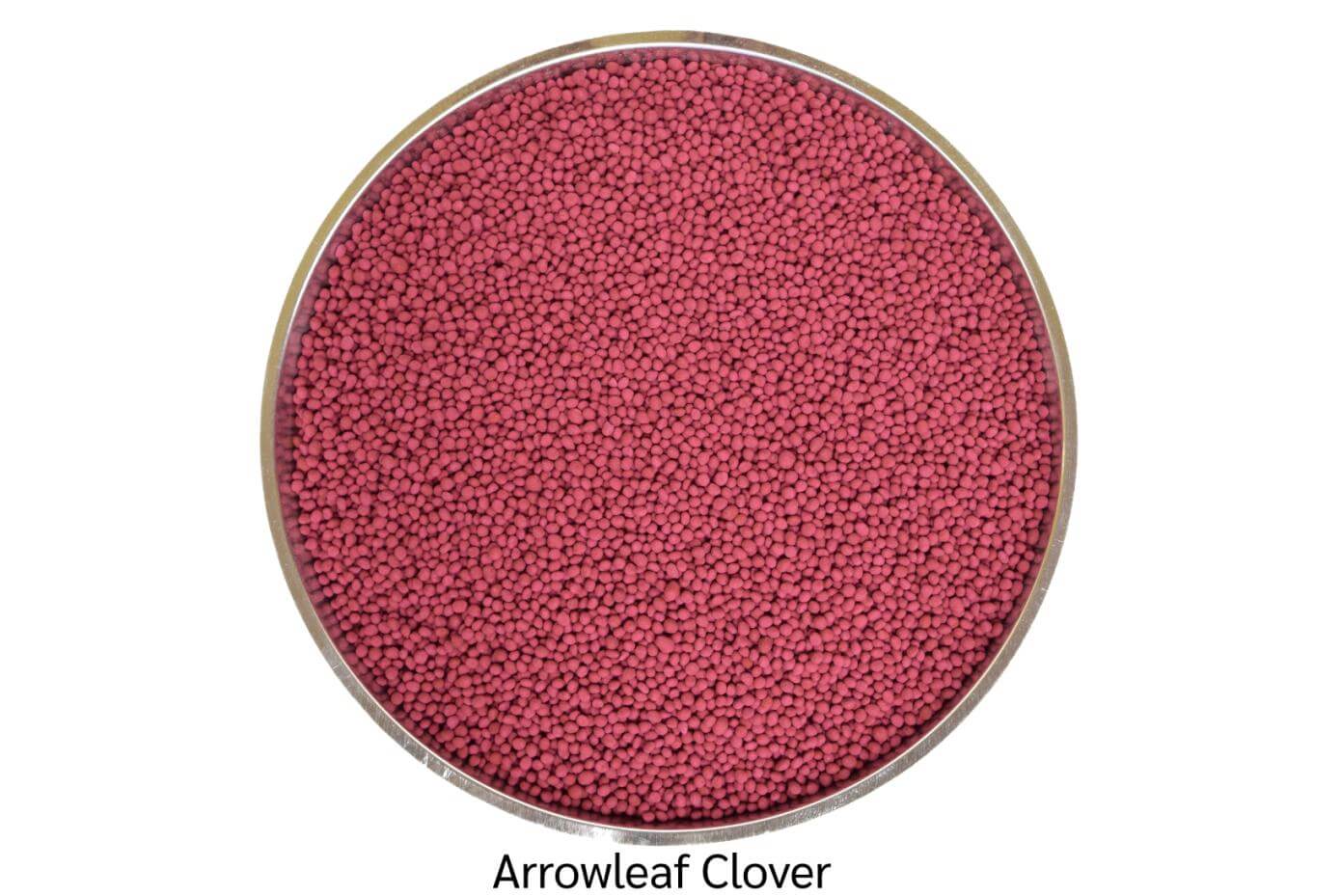Arrowleaf Clover Trifolium Vesiculosum Savi
Arrowleaf is a drought-hardy clover with very distinct arrowhead-shaped leaves, pronounced veins, and distinguishing white markings.
Drought hardy.
Arrowleaf is drought hardy! However, arrowleaf does have its limitations. It doesn’t like wet soils, acid soils or shade. The shade factor comes into play if it gets too tall, which causes lower leaves to die and become susceptible to disease. It is best to graze at 6 inches, let it regrow, and either graze again or take for hay.
Great for late spring forage.
Arrowleaf is a favorite among Southerners who want late spring forage. It can be sown in the fall with other legumes, such as crimson, ryegrass, rye and oats. Arrowleaf delivers abundant tonnage late in the spring, filling the last forage gap before the warm season grasses kick in.
Good eating.
With upright growth of up to 48 inches, Arrowleaf can be grazed or cut for hay. It produces 1.5-2 tons DM/A in one growing season. Aside from horses, livestock and wildlife willingly forage on Arrowleaf, without worry of bloat.
Coat for optimal performance.
In order to achieve optimal nitrogen fixation ability, arrowleaf clover needs to be inoculated with Rhizobium leguminosarum biovar trifolii (vesiculosum). This is best achieved with Nitro-Coat®. A detailed brochure on arrowleaf is available from the Oregon Clover Commission at OregonClover.org (source of photo, too.)
As far back as 1972, Auburn University researchers understood that coating arrowleaf clover resulted in higher forage yields. This data was first published in the Agronomy Journal #64. In one treatment the seed received inoculum and a coating to seal in the inoculum. On the second treatment the inoculum was put on the seed, without a coating. The table shows the results of the trial.
Coated vs. Uncoated Arrowleaf (DM/A)
| Seed Treatment | Tallassee | Pratville |
|---|---|---|
| Coated Seed | 870 | 1,520 |
| Uncoated Seed | 290 | 500 |
| Increase due to coating | 580 | 1,020 |
Arrowleaf Clover Specifications
Planting
- Zones
- Zones 7, 8 and upper part of zone 9
- Longevity
- Annual
- Ease of Establishment
- Good
- Seeds/lb
- 400,000
- Seeding Rate - Straight
- 5-10 lbs/ac
- Seeding Rate - Mix
- 3-8 lbs/ac
- Seeding Time
- September - Early November
- Seeding Depth
- 1/4 - 3/8"
- Seeding Method
- Broadcast or drilled (preferred)
- Method of Killing/Suppression
- Mowing; grazing; chemical
- Optimal Germination Temperature
- Night temperatures > 40°F
- Seedling Emergence/Vigor
- Fair
- Reseeding Potential
- Excellent
- Root Type
- Tap
Usage
- Grazing Potential
- Good
- Hay Potential
- Good
- Use with Wildlife
- Good
- Use in Orchards
- Good
- Use with Row Crops
- Good
- Use with Other Grasses/Legumes
- Excellent
- Bees/Beneficial Insects
- Good
- Compaction Control
- Fair
- Erosion Control
- Fair
- Weed Suppression Potential
- Good
- Green Manure/Cover Crop Use
- Good
- Spreading Capability
- Fair
- N Contribution Potential
- Good
- DM Potential
- Good
- Forage Quality
- Good
- Harvest Time Frame (late/early/year-round)
- Late
- Number of Harvest/yr
- Up to 3 per growing season
- Other Comments
- Overseeding bermudagrass sods with arrowleaf clover in mixtures with rye and/or ryegrass can provide excellent winter-spring grazing.
Tolerance
- Bloat Risk
- Rare
- Disease Resistance
- Moderate
- Insect/Nematode Risk
- Moderate
- Cold Tolerance
- Fair
- Traffic Tolerance
- Good
- Heat Tolerance
- Good
- Drought Tolerance
- Good
- Shade Tolerance
- Poor
- Dry Soil Tolerance
- Good
- Wet Soil Tolerance
- Poor
- pH Range
- 5.8 - 6.5
- Required Fertility (P,K, other nutrients)
- Not tolerant of acid soils or low fertility; responds to P and K fertilization.
